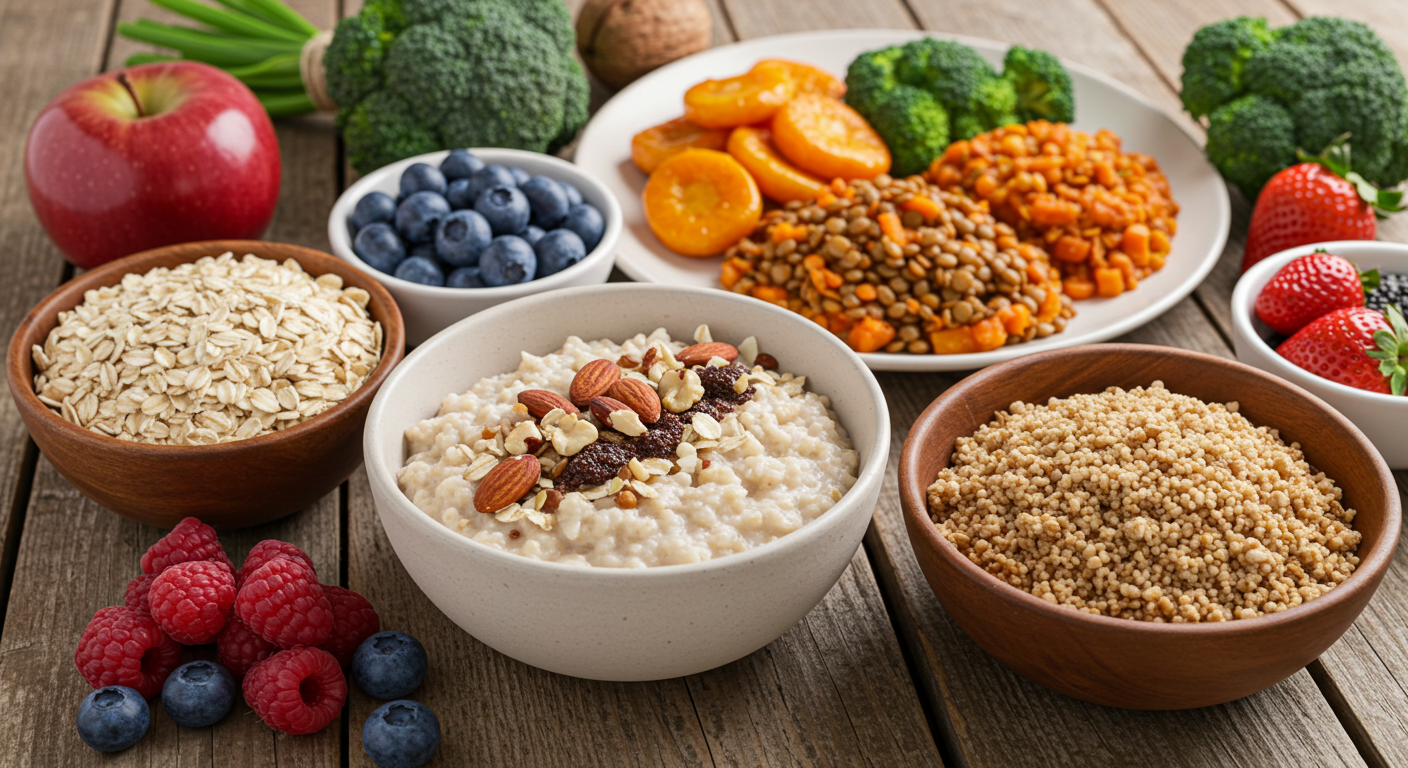Dr. Kumar’s Take:
This study reviewed 31 meta-analyses and found a strong connection between high fiber intake and a lower risk of heart disease and stroke. Adding more fiber—especially from oats and psyllium—can improve your cholesterol and may help you live longer. Aim for at least 25–38 grams of fiber a day from whole foods like fruits, vegetables, beans, oats, and seeds. Supplements like psyllium can also help, especially if you’re trying to lower LDL cholesterol.
Key Takeaways:
✔ Up to 28% lower risk of dying from heart disease with high fiber intake
✔ LDL (“bad”) cholesterol dropped by 10–13.5 mg/dL with psyllium or beta-glucan
✔ Most benefit seen with 6g/day of beta-glucan or 10g/day of psyllium
✔ Minimal side effects—mostly bloating or gas
Brief Summary:
This umbrella review examined 31 meta-analyses published between 1980 and 2017, looking at the effects of dietary fiber on cardiovascular disease (CVD), cholesterol, blood pressure, and mortality. The evidence showed that people who ate the most fiber had a lower risk of dying from CVD and a lower chance of getting heart disease or stroke. Soluble fibers like beta-glucan (from oats/barley) and psyllium (from Plantago seeds) were especially effective in lowering LDL cholesterol by about 10–13.5 mg/dL.
Study Design:
- Type: Umbrella review of 31 meta-analyses
- Data Source: PubMed and CINAHL, studies from 1980–2017
- Included outcomes: Cardiovascular events, mortality, serum cholesterol, and blood pressure
- Participants: Over 800,000 across included studies
- Quality: 71% of meta-analyses were rated high quality
Results:
| Outcome | Relative Risk Reduction (High Fiber Intake) | Relative Risk Reduction (Low Fiber Intake) |
|---|---|---|
| Cardiovascular disease | 28% | 9% |
| Cardiovascular mortality | 23% | 17% |
| Stroke | 17% | 7% |
- This translates to a 17–28% relative risk reduction.
Cholesterol:
- LDL reduction with psyllium (10g/day): 10.8–13.5 mg/dL
- LDL reduction with beta-glucan (6g/day): 7.3–25.5 mg/dL
- Estimated CVD Absolute Risk Reduction: ~2–4% over 10 years for high-risk individuals
- Estimated Number Needed to Treat (NNT): ~25–50 people need to increase fiber to prevent 1 cardiovascular event over 10 years
Blood Pressure:
- Slight reduction in diastolic BP (1.65–1.77 mmHg); no major change in systolic BP
Inflammation:
- Higher fiber intake was linked to lower markers of inflammation like CRP and IL-6.
How Fiber Works
Fiber helps your body in multiple ways:
- Soluble fibers bind cholesterol in the gut and reduce how much gets absorbed.
- They also feed good bacteria in your gut, creating short-chain fatty acids that reduce cholesterol production in the liver.
- Fiber-rich diets help lower blood sugar spikes, improve insulin sensitivity, and may lower blood pressure slightly.
- Fiber reduces inflammation, possibly by increasing intake of beneficial polyphenols and antioxidants from plant foods.
Related Studies and Research
Plant Sterols, Cholesterol, and Heart Health – Reviews how plant sterols impact cholesterol levels and their potential role in heart disease prevention.
Fibrates and Cardiovascular Risk Reduction – Explores the role of fibrates in lipid management and their effect on heart disease risk.
Red Yeast Rice and Metabolic Syndrome – Investigates how red yeast rice affects lipid levels and metabolic markers in people with metabolic syndrome.
Ezetimibe and Heart Disease: A Review – Examines how ezetimibe lowers LDL cholesterol and its effect on cardiovascular outcomes.
Mediterranean Diet and Heart Disease: A Primary Prevention Study – Analyzes how dietary patterns influence primary prevention of cardiovascular disease.
PURE Study: Dietary Fats, Carbs, and Heart Health – Reviews large-scale evidence on diet composition and heart disease outcomes.
Frequently Asked Questions
What types of fiber are best for heart health?
Soluble fibers like psyllium and beta-glucan are best for lowering cholesterol. You’ll find them in oats, barley, flaxseed, and psyllium husk.
How much fiber should I eat daily?
The recommended intake is 25 grams for women and 38 grams for men. Most Americans only get about 17 grams.
Can fiber replace statins or other medications?
No, but it can complement them. Talk to your doctor before stopping any medication.
Are there any side effects from eating more fiber?
Some people may get bloating or gas, especially if increasing intake too quickly. Add fiber slowly and drink more water.
Conclusion
This umbrella review strongly supports the idea that increasing fiber intake—especially soluble fibers like beta-glucan and psyllium—can reduce cholesterol and lower your risk of heart disease and stroke. While fiber isn’t a magic bullet, it’s a powerful, natural tool that belongs in every prevention plan.
Aiming for 25–38 grams per day from whole foods or supplements can provide meaningful heart benefits—often without side effects.


